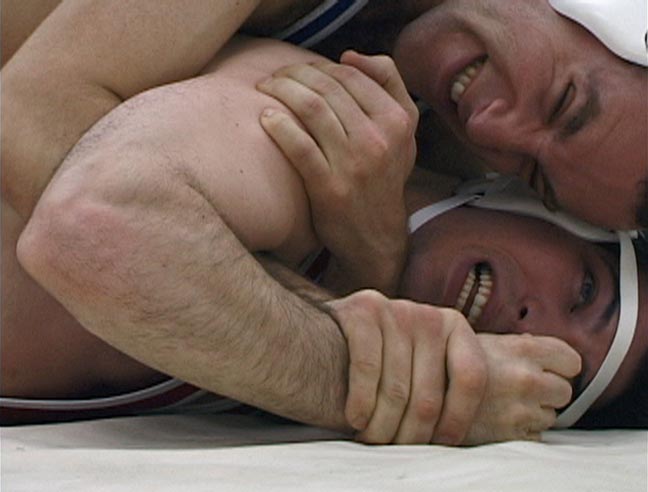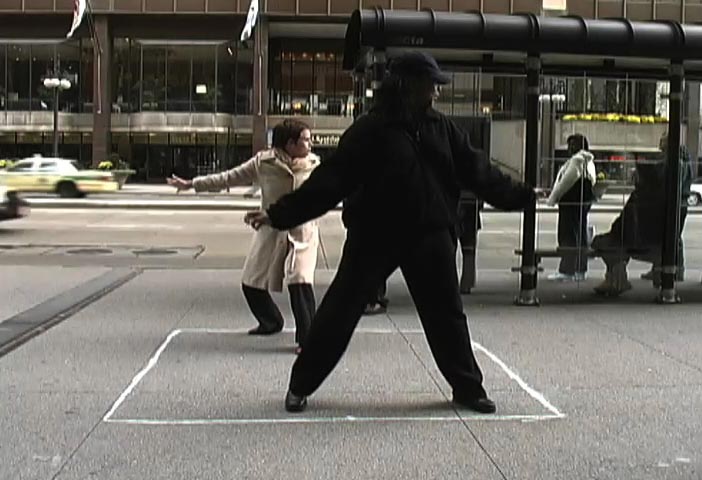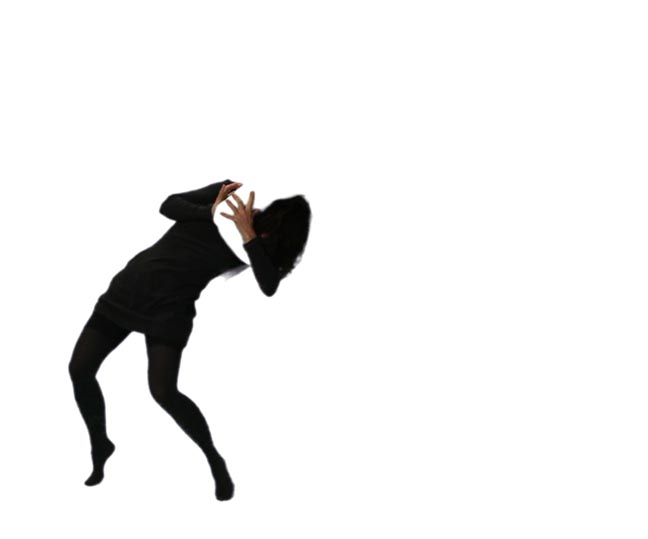
|
||
|
Portland art blog + news + exhibition reviews + galleries + contemporary northwest art
|
||
Let's Get Physical: a kinesthetic aesthetic at Place 
Still from Type A's Dance "Physical"... Like I need that Olivia Newton-John song in my head... Nothing more than an excuse to peddle herself in a leotard, or for those so inclined, a goggle at oily beefcake. But there it is, competing with the tunes of my choosing as I write, and I rail. "Let me hear your body talk." This aural struggle is apropos to the exhibit at Place. Or, the work is as the curator, Marina Tres, states: "Artists address and utilize the physical self, movement and action as an integral instrument and method in their visual works. They ask - how does the body adapt, protect, resist, control or relinquish control, react and express in a self-designed and self-enclosed performance or action." Which, although descriptive of a process toward an outcome, says about as much as her reference to online personas in the opening sentence of her statement. Don't get me wrong. I like this exhibit. It's just that one must be careful that the stated intent is not overreaching, and despite the accompanying statement, Tres has otherwise struck a nice balance in her curation. The widely accepted notion, at least among self-professed artists, is that life is art. And, if that is so, then it magically follows that everyone is an artist, which I'd be happy to embrace if making art was not such a struggle with that as the intended goal. The life of an artist is one of sacrifice. Art about struggle, whether emotional or political, even as performance... well, it's still art. Or, perhaps I'm just in one of my "moods," and given some time to gather myself will recognize the elevation of a rationale beyond relative indulgence is also a struggle, and therefore art. Maybe. But I'd rather prefer to think art is much like the fun I'm having as, knife-to-nose, I write this paragraph. By and large, so do some of the artists in this exhibit. Rachel Ellison has made a video in which she tries to maintain a broad smile, teeth showing, for fifteen minutes. It is the type of smile that we can easily imagine becoming exhausting for the facial muscles, and anticipate the eventual change to a grimace. She apparently wishes it to remain a frozen smile, and so the viewer can watch closely for any change, the smile takes up almost the whole frame. And there is drool. While we might guess that the contrived smile makes a simple point, perhaps to highlight the pain hidden behind, or to act as a commentary on inauthenticity in others, the drool acts as a pratfall. She has debased herself for our benefit. This tactic, it can be argued, is the same in any art that light-heartedly addresses our (or the artist's) abject nature. Bad Painting fulfills the same goal and all such art may in fact be something akin to what is known from Psychology 101 as the pratfall effect. Part of attraction theory, one strategizes to make a simple, non-threatening mistake, to appear clumsy or imbecilic in order to appear a lesser being than the person one wishes to attract. In turn, this engenders a sort of nurturing and a consequent likability factor. Ellison's drool is aesthetic.  Still from Lilly McElroy's Square Piece Lilly McElroy employs the same sort of contrivance in her piece, "The Square - After Roberto Lopardo." The set-up is a chalk-drawn square on a busy sidewalk in Chicago. McElroy positions herself inside the square and tries to block pedestrians from entering into the space. Her success or lack thereof is of little consequence in the task itself, except that the exercise speaks more to each passer by and whether he or she decides to transgress or walk around. Although McElroy tries to maintain a deadpan, serious countenance throughout, she clearly smiles on a number of occasions, which while understandable, somehow lessens the symbolism of this act. Yet, what is perhaps the most remarkable aspect of this piece is a woman who comes along and decides to help McElroy protect her - now their - space, and McElroy allows this to happen. To allow another into one's personal space requires improvisation and sometimes compromise. McElroy ends up with effectively half of her marked-off territory, so it might have been interesting to see her eventually eject her partner from the square. Type A's (Adam Ames and Andrew Bordwin) series of vignettes explore all of these scenarios for cooperation and competition, moving from compassion to (literally) pissing contests. Again, especially in the depictions of the latter, they rely a significant amount of humor; or else what is meant to represent conflict not of one’s own making becomes funny. It allows us to recognize situations in which we may indeed be deadly serious - ego serious - and laugh. On the other hand, their video, "5 Urban Rescues" is meant to explore our more compassionate side, setting up scenarios in which one "player" (as their statement about the piece calls each actor) rescues the other from life-threatening situations. While well-staged, even cinematic, they lack the access to emotion that exists in watching their "5 Urban Contests" or "Dance." Physical conflict, we readily understand; compassion requires character development.  Still from Heidi Schwegler's Wrest As a counterpart, Heidi Schwegler's "Wrest" depicts a struggle to escape the grasp of a hidden opponent, the way we struggle with our inner demons. Clearly overwhelmed by the strength of this nemesis, the attempt is nevertheless continued, as she flails about, never resting against the unrelenting. Fruitless. Although staged, we feel her exhaustion. As a looped video, it's a permanent state of melancholy, out of which is why art is made, not as an expression of the melancholic, but to step out of it. If you will, a sort of mania, hyperbolic for effect (Colt Toombs, a mixed martial arts fighter and son of professional wrestler Rowdy Roddy Piper is green-screened out of the video), and in that it is art, there is little danger involved. Yet, and perhaps not part of Schwegler's intent, associations of assault and rape are not too far off, and back to the ONJ video I go: just as art is a stand-in for some serious issues, so a body is displaced as an object for fantasy. As if. After all, the body is a frail thing, and hopes of love, clarity, release from grief, and even immortality, although part of the physical process of the brain, seemingly originates elsewhere, in the metaphysical aspect of being that is the mind. This is the tragedy of being. Yet, something seemingly so simple, that we are whole beings, can still be so awkward and complicated to the point of undoing, this is also from which comedy springs. On the perfect Aristotelian stage it is tragicomedy, and this is what makes this exhibit wholly worthwhile. Posted by Patrick Collier on July 10, 2012 at 21:33 | Comments (0) Comments Post a comment Thanks for signing in, . Now you can comment. (sign out)
(If you haven't left a comment here before, you may need to be approved by
the site owner before your comment will appear. Until then, it won't appear
on the entry. Thanks for waiting.)
|
| s p o n s o r s |
 |
 |
 |
 |
 |
 |
 |
 |
 |
 |
 |
 |
 |
 |
 |
 |

|
Site Design: Jennifer Armbrust | • | Site Development: Philippe Blanc & Katherine Bovee | |

